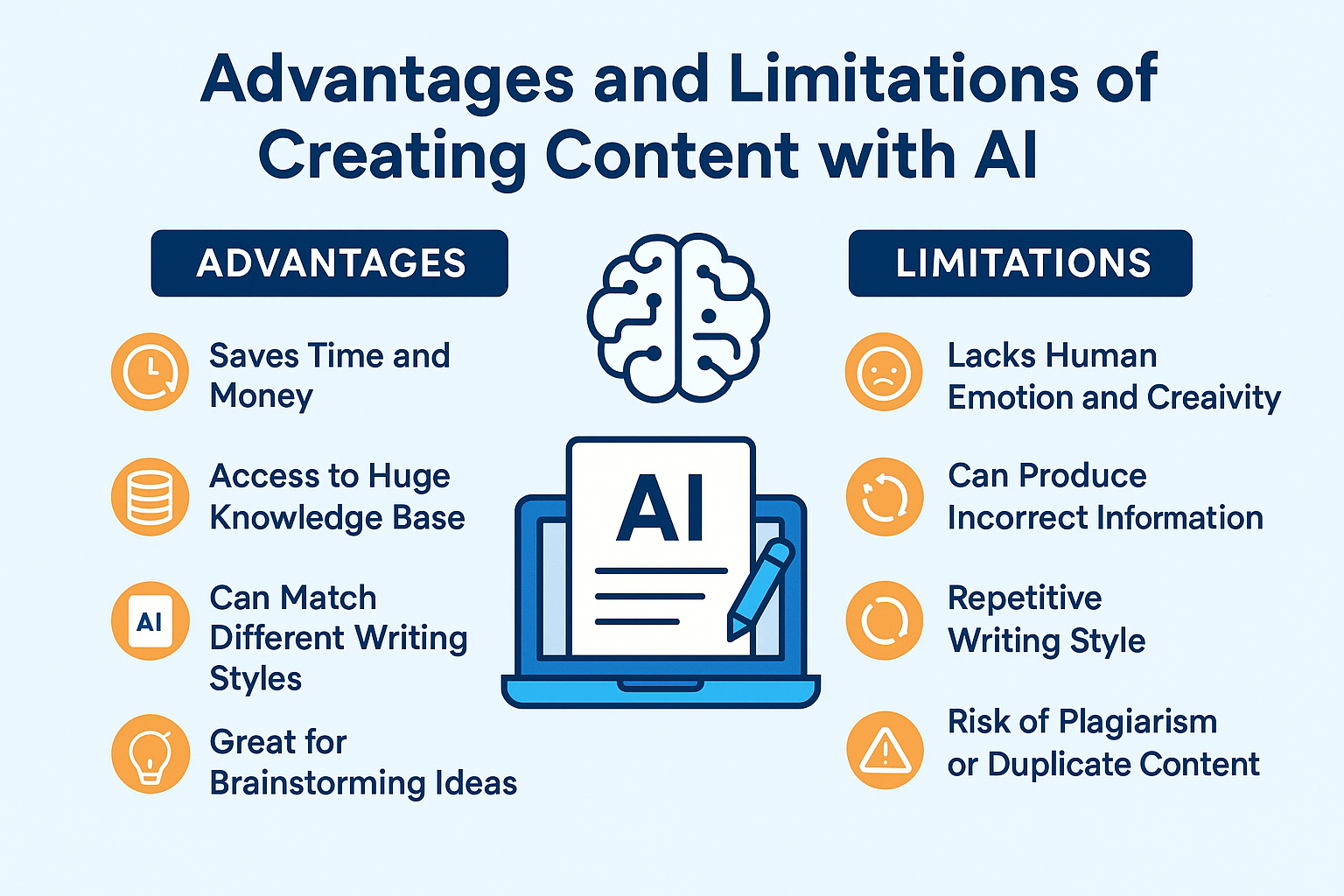Breakthrough insights on AI writing: Make informed decisions about integrating Creating Content with AI into your content workflow.
In today’s digital world, content is everywhere. From blogs and social media to news articles and product descriptions—content plays a key role in connecting with an audience. But creating high-quality content regularly can be time-consuming and expensive. That’s where Artificial Intelligence (AI) comes in.
AI content tools like ChatGPT, Jasper, Copy.ai, and others are transforming how content is created. They can write articles, social media posts, emails, and even stories in just a few seconds. But is AI-generated content always the best option?
In this blog, you’ll learn:
- The main advantages of AI-generated content
- The limitations and potential risks
- When AI works best
- What the future of content writing looks like with AI
Let’s dive in.
Advantages of AI-Generated Content
1. Saves Time and Money
First and foremost, using AI to write content saves a lot of time. Instead of spending hours researching and writing, you can generate a full blog post in just minutes. As a result, businesses and content creators can save money on hiring writers or freelancers.
2. Access to a Huge Knowledge Base
AI tools are trained on massive amounts of online information. Therefore, when you ask them to write about a topic, they can gather facts, ideas, and insights from various sources quickly. This makes it easier to create informative and well-structured content.
7 Effective Ways to Protect Yourself from Cyber Attacks
3. Can Match Different Writing Styles
One major benefit of AI is flexibility. You can tell the AI to write in a friendly tone, formal language, persuasive style, or even in a storytelling format. It adapts based on your needs.
4. Supports Multiple Languages
If you need to translate your content or write in different languages, AI can help. Many tools support English, Spanish, Bengali, and other languages. Therefore, reaching a global audience becomes much easier.
5. SEO-Friendly Suggestions
In addition, AI tools often suggest SEO-friendly keywords, headlines, and meta descriptions. This improves your chances of ranking higher in search engines like Google. Consequently, your content can attract more traffic.
6. Great for Brainstorming Ideas
When you’re stuck and not sure what to write about, AI can help generate blog topics, headlines, outlines, and even catchy titles. Hence, it’s a great assistant for planning your content strategy.
Limitations of AI-Generated Content
Despite all the benefits, AI is not perfect. Here are some important limitations to keep in mind.
1. Lacks Human Emotion and Creativity
While AI can generate grammatically correct content, it often lacks human emotion. Emotional storytelling, personal opinions, and unique creative angles are hard to replicate. That’s why AI writing may feel flat or robotic at times.
2. Can Produce Incorrect or Outdated Information
AI doesn’t always give accurate or up-to-date facts. If you’re writing about current news, research, or statistics, it’s important to double-check everything. Otherwise, you may end up sharing wrong information.
3. Repetitive Writing Style
Over time, you might notice that AI tends to repeat certain phrases or follow a fixed structure. This can make your content feel repetitive or generic. Therefore, manual editing is often necessary.
4. Not Ideal for Deep Research or Unique Insights
AI can only work with information that already exists. It cannot come up with original theories or in-depth analysis. So, if your content requires expert knowledge or new ideas, AI won’t be enough.
5. Risk of Plagiarism or Duplicate Content
Even though AI tools try to avoid copying, sometimes they generate content similar to existing online texts. If you’re not careful, this could cause plagiarism issues or lower your Google ranking. That’s why checking your content with a plagiarism tool is a must.
6. Google Can Detect AI Content
Recently, Google has updated its algorithm to identify low-quality AI content. If your writing seems robotic or lacks value, it may not rank well. As a result, it’s better to edit and personalize AI-generated content before publishing.
When AI Content Most Useful?
AI works best in simple, structured writing tasks. For example:
- Blog outlines and summaries
- Product descriptions
- Social media posts and captions
- Email newsletters
- Frequently Asked Questions (FAQs)
- Grammar and style correction
- Translating content
However, for personal stories, emotional blog posts, or deep expert content, it’s better to write manually or heavily edit the AI output.
The Future of Content Writing with AI
AI is evolving fast. New tools can now generate not just text but also images, videos, and even voice content. In the near future, content writing may become a mix of AI efficiency and human creativity.
Instead of replacing human writers, AI is more likely to become a powerful assistant. The best content will come from combining human ideas with AI tools.
Human + AI = Best Results
Use AI to speed up your writing. But always add your own thoughts, voice, and emotion to make your content more engaging.
To sum up, creating content with AI offers many benefits, such as saving time, boosting SEO, and generating ideas quickly. But at the same time, it has limitations like lack of creativity, possible errors, and plagiarism risks.
If you want to succeed with AI content, here’s what you should do:
- Use AI to draft your content
- Check facts and update information
- Add your own thoughts and personal stories
- Make the tone natural and human-friendly
- Always run a plagiarism check before publishing
